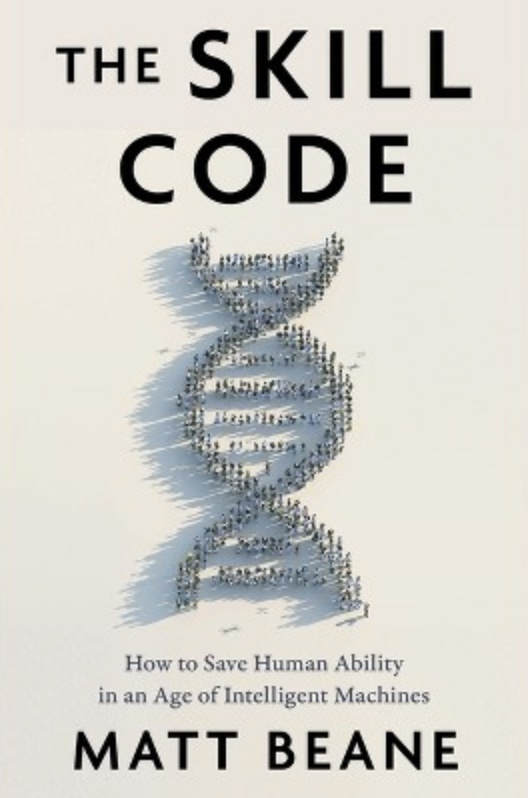Key Quote:
“Our challenge and opportunity: learn with intelligent machines so that we can show future generations how to do the same” (181).
Key Points and Concepts
The Power of Apprenticeship and Healthy Challenge
Beane emphasizes the enduring value of the traditional apprenticeship-expert relationship in skill development, from high-end kitchens to surgical suites. Beane breaks down the development of any apprentice or learner into three dimensions, which he refers to as the “three Cs”.
“The first key insight in this book is that the working relationship between experts and novices is a bundle of three Cs that humans need to develop mastery: challenge, complexity, and connection” (5).
• Challenge: Push learners to the limits of their skills, while providing a supportive environment.
“We learn best when we get a healthy challenge: too much, and we burn out. Too little and we stagnate” (19).
• Complexity: Expose apprentices to progressively sophisticated work.
“When you have healthy complexity, you understand more and more of the context for your work over time, and this lets you move from a narrow skill set to a broader one, suited to a wider range of problems” (40).
• Connection: Cultivate a meaningful relationship between novices and experts, fostering trust and respect.
“So, if challenge and complexity are more about the ‘how’ of skill, [connection] is more about the ‘why’ — more to do with a rich, complex, and very human landscape built on warm bonds of trust and respect” (63).
“Mentor-mentee relationships are a special, durable kind of expert-novice connection that can last for years” (68).
Navigating the Threats to Skill Development
Technology advancements and the shift to virtual work environments have led to a critical disconnection within workplaces, affecting mentorship dynamics. Automation and AI threaten to dilute hands-on learning experiences and decrease complex interactions that foster professional growth.
• New technologies are dramatically reshaping the landscape of work and skill development.
“New tools such as machine learning, sensors, robotics, and cloud computing allow us an unprecedented ability to reconfigure jobs in search
of improved results” (89).
“We are embracing these technologies in ways that reduce meaningful involvement for millions of workers throughout the global economy” (96).
• These new technologies are disrupting traditional apprenticeship models, raising concerns about the development of future experts.
“By virtue of the fact that they [apprentices] are still learning, we have to recognize that involving them increases risk and slows things down, and that there’s an immediate upside in quality and profit if we let experts do their thing. But it also raises the question: How will the next generation of doctors, firefighters, programmers, teachers, lawyers, electricians, and filmmakers become experts themselves?” (92).
“We get a little formal training and then we figure it out. From each other. On the job. That’s how it’s worked for probably 160,000 years, and we could count on it to help all of us adapt. We took it for granted. We can’t anymore” (96).
• The loss of connection, challenge, and complexity in work environments is hindering skill development.
“One of the most valuable tools in our toolbox — the bond between expert and novice — is being compromised for short-term wins, just when we need it most” (97).
“Deploying intelligent technologies often deprives workers of the challenge they need to grow their expertise” (102).
“All of us are losing access to the complexity that allows us to act skillfully, just as the world becomes increasingly complex” (106).
The Future of Skill Development: Digital Apprenticeships
Beane introduces the concept of “shadow learners” — individuals who use unconventional methods to develop and enhance their skills in highly automated environments. He identifies these individuals as those who practice novel approaches to skill development in highly automated environments. Beane stresses that apprentices should not be forced to learn in the shadows, and instead we should create new ways of learning within automated environments, allowing both novices and experts to adapt to technological changes while maintaining the core principles of effective learning. Without a structured approach to new ways of learning, many of us will soon need “to find a new way to learn, without help, and against the rules” (115).
Beane’s research reveals three distinct practices that shadow learners employ to overcome the challenges posed by highly automated environments. These practices are designed to preserve the essential elements of skill development—challenge, complexity, and connection — even when traditional apprenticeship models are disrupted.
“I’ve since found these practices in studies done by other researchers and in my own studies in other contexts, ranging from policing to data analytics. There are three of them and each one represents a way that novices preserve healthy challenge, complexity, and connection in an environment that was incredibly inhospitable to skill development” (122).
Using his years of research studying resident doctors in hospital settings, Beane lays out these practices alongside real-word examples.
• Premature specialization: Take the time early in a career to develop the skills to work with new technology.
One attending doctor said of their first-year resident: “‘I can already tell, [first-year resident is] great, she’s better than most chiefs [sixth-year residents], but she spent a significant amount of her life, like one to two years, in the robot lab at [hospital X] doing research, so it’s like cheating, you know?’” (123).
• Digital rehearsal: Use video tutorials or simulations to practice and learn skills outside of real-world scenarios.
“The other shadow learners out there spent huge amounts of time carefully dissecting videos on YouTube as a way of completing their learning in the OR [operating room]” (123).
“Sometimes instead of YouTube, they used the robotic simulator in the hospital’s training lab” (124).
• Under-supervised struggle: Find opportunities to work independently near the limits of one’s abilities, with minimal but available oversight.
In reviewing his research on resident doctors, Beane observed, “Some residents found ways to operate with far less supervision. Some rotated to other, lower status hospitals where senior surgeons weren’t all that experienced with the robot.
Or to departments within their own hospital that were newer to the robot” (125).
“Two things were central: One, the resident was working near the edge of their capability. Extremely focused. Sweating in the console, even. But two, an attending was always available, so residents could pull on them for help” (125).
Beane also introduces the concept of “inverted apprenticeship,” which describes one way experienced professionals adapt to new technologies. This process often involves a reversal of traditional roles, with experts becoming learners in specific technological contexts.
“When experts run up against new technologies that they don’t know how to use, they take one of four pathways: seeking, stalling, leveraging, or confronting. All of these are forms of inverted apprenticeship” (132).
The only pathway, however, which benefits both expert and apprentice is that of “seeking”. Darren, a senior banker in one of Beane’s studies, is a practitioner of this method, “Where the senior expert preemptively pulls promising novices away from their work, and all parties learn a lot by struggling together with the new technology” (132).
Ways to Rework the Skill Code
Beane proposes a paradigm shift in how we approach skill development in the age of AI, introducing the “three Ds” (Discover, Develop, and Deploy) to employ the “three Cs” (Challenge, Complexity, and Connection) in increasingly automated environments:
“A healthy set of guidelines isn’t far away — all we have to do is shift from the three Cs to the three Ds, a set of mutually reinforcing activities that nurture human skill and adaptability: discover, develop, and deploy” (141).
• Discover: Identify approaches that maintain the skill code.
“We have to discover the specific approaches that preserve the health of the skill code in our contexts” (141).
“How is the threat to skill showing up where you are? How do healthy challenge, complexity and connection show up in contexts that matter to you? Where are they under threat, and how, specifically? On both fronts: Why? If you want to improve the skill situation for you and your
coworkers, you need these specifics to inspire and inform the collective action required for change” (143).
• Develop: Create organizational structures and technologies that balance productivity with the essential elements of skill development.
“Then we need to develop organizations and technologies that foster both productivity and healthy challenge, complexity, and connection” (142).
“Whether it’s in midwifery, acting and film production, hospitality, or firefighting, new technology means you’ve got new experts peppered in the organization around you, and everyone can win if you formalize that” (152).
• Deploy: Consider the practical implementation of technology and the associated changes in work processes.
“Finally, we have to consider how we deploy technology: how we alter various work processes, who we involve in that, and how we configure technologies to suit” (142).
“Deployment is when your plan makes contact with reality, and where you have to take a stand for skill” (155).
The ultimate goal of this framework, as Beane presents it, is to learn alongside intelligent machines in ways that allow us to pass on this ability to future generations, ensuring the continued flourishing of human expertise in an increasingly automated world.
“People, relationships, and choices sit at the core of this book, not technology” (179).
Beane, M. (2024). The Skill Code: Mastering Human Expertise in the Age of AI. HarperCollins Business.

“In reviewing his research on resident doctors, Beane observed, “Some residents found ways to operate with far less supervision. Some rotated to other, lower status hospitals where senior surgeons weren’t all that experienced with the robot. Or to departments within their own hospital that were newer to the robot.”
“How is the threat to skill showing up where you are? How do healthy challenge, complexity and connection show up in contexts that matter to you? Where are they under threat, and how, specifically? On both fronts: Why? If you want to improve the skill situation for you and your
coworkers, you need these specifics to inspire and inform the collective action required for change.”
“The ultimate goal of this framework, as Beane presents it, is to learn alongside intelligent machines in ways that allow us to pass on this ability to future generations, ensuring the continued flourishing of human expertise in an increasingly automated world.”
“People, relationships, and choices sit at the core of this book, not technology.”
